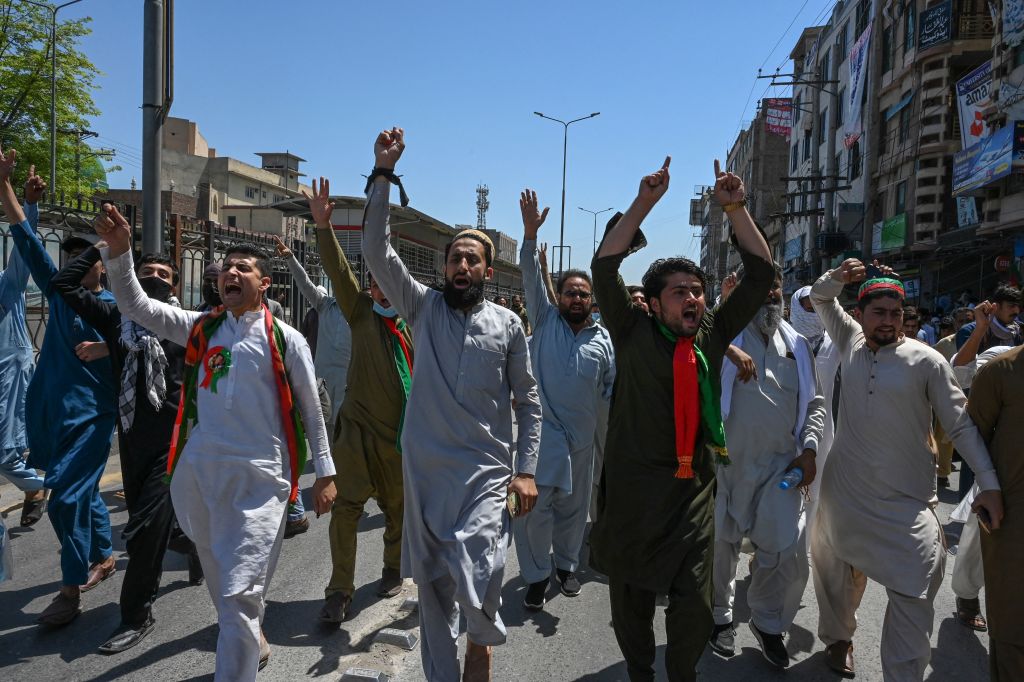Simmering political tensions risk boiling over into a full-blown governmental collapse in nuclear-armed Pakistan. At the heart of the brewing crisis is Imran Khan—a popular former athlete and recently ousted prime minister.
On May 9 a local paramilitary group dragged Khan from an Islamabad courtroom and placed him under arrest. He was released later that week after spurring his supporters on in a wave of political violence, including attacks on military installations and government buildings. Pakistan’s streets have remained quiet since the initial violence, but many of his supporters are still behind bars, and droves of high-ranking officials with Khan’s Pakistan Tehreek-e-Insaf (PTI) political party have severed ties with the group and its leader in recent weeks. There’s even discussion of banning the party from participating in Pakistan’s upcoming elections.
How concerning is the popular leader’s ability to foment political instability in the world’s fifth most populous country? When were the seeds of this looming constitutional crisis sown? Is Khan a victim of Pakistan’s overzealous military leadership, or a populist demagogue frustrated that the political system he helped create has turned against him?
Who is Imran Khan?
A former cricket star with a penchant for public speaking, Khan has been on Pakistan’s national political scene since the late 1990s. But the celebrity’s political star only began to rise after the military threw its weight behind him. It propelled Khan to the premiership in 2018 by helping him and his party craft effective social media campaigns and grievance-based appeals.
“To understand Khan, my simplest advice to an American is to look at Trump,” says Husain Haqqani, a former Pakistani ambassador and current scholar at Washington D.C.’s Hudson Institute and the Anwar Gargash Diplomatic Academy in Abu Dhabi. “He’s offered no solutions, but he has given a voice to widespread anger and dissatisfaction.”
In true populist fashion, Khan tends to cater his beliefs to his audiences—an Islamist when speaking to devout Muslims, staunchly anti-Indian and anti-American when stirring nationalist passions, and a modern reformer when engaging with foreign journalists. Much of Khan’s support has come from military families, young voters, and middle-class Pakistanis who don’t feel at home in either the center-left or center-right parties that have long dominated the country’s civilian government.
In office, Khan toed the military line on a number of issues and doubled down on many of its more repressive tendencies, including stifling press freedom and jailing his political opponents. He also diverted Pakistan further from U.S. interests during his tenure, continuing Islamabad’s support for the Taliban in neighboring Afghanistan and fostering closer economic ties with China. But Khan turned on his military backers after a 2022 no-confidence vote removed him from office, accusing Pakistan’s generals of colluding with the West to have him removed. He also says the armed forces plotted a botched assassination attempt last year, during which he was shot in the leg. The government, meanwhile, claims the attack was carried out by a lone gunman with religious motivations.
Why is he rallying his supporters now?
Khan racked up more than 100 charges since his ouster, including for corruption and sedition. After his arrest last month, Khan called on his supporters to fight back—and they did. They attacked public buildings, burned vehicles, wielded assault rifles, and hurled Molotov cocktails at police officers. Authorities responded with tear gas and rubber bullets, but they later released Khan on bail. He’s now staying at his Lahore residence, under what some have described as effective house arrest.
Khan claims some 10,000 of his supporters were arrested in last month’s chaos, including 4,000 on terrorist charges (though many analysts argue those numbers are greatly inflated). While Khan says they’ve been unjustly detained, his successor—Prime Minister Shehbaz Sharif—has accused Khan’s party of trying to throw the country into civil war and likened the events of May 9 to the January 6 Capitol riots.
Khan’s supporters were caught off guard by authorities’ swift and severe response to the rioting, and many apparently expected the military to join in their acts of rebellion rather than turn on their leader. Instead, the uprising sputtered out. Mohammed Hanif, a British-Pakistani author, recently described the events of May 9 as “less of a revolution” and “more of a lovers’ spat.” So it’s unlikely that Khan’s base will stage a popular uprising in Pakistan any time soon. “Many of them are realizing that it’s easier to tweet admiration for Khan than it is to go to prison for Khan,” Haqqani tells The Dispatch. “He overplayed his hand.”
How will this affect Pakistan’s path to democracy?
Pakistan’s path to democracy has been a tumultuous one. Its current transition to civilian rule began in 2008, but the country has never fully broken away from its history of military interventions in politics. Several prime ministers have been removed from office on often trumped-up corruption charges—and none has ever completed a full five-year term under the 1973 constitution. When Khan urged supporters to have his back in what many saw as a quasi-revolutionary cry last month, he broke an unspoken rule that leaders out of favor with the military must go quietly and wait their turn for the next election.
This tactic and the ensuing violence has given the military pretext to crack down on Khan and his party, destabilizing the country’s already fragile democratic system. Reading the writing on the wall, dozens of members of Khan’s PTI have tendered their resignation in recent weeks—described by Khan as “forced divorces.” Pakistani Defense Minister Khawaja Asif last week said Khan and his party had attacked the “very basis” of the state and may be prohibited from taking part in this year’s elections. Interior Minister Rana Sanaullah said on Tuesday the party chair will be tried in a military court for his role in instigating the attacks.
These developments are likely to create less, not more, room for democracy going forward. “Pakistan is a national security state, its people do believe that the military is important for their survival. While they may not like its political meddling, they certainly do not like the idea of attacks on military installations,” Haqqani says. “And by doing that, Imran Khan has not only risked his own political future, but has also weakened the prospect of civilian supremacy within the political sphere.”







Please note that we at The Dispatch hold ourselves, our work, and our commenters to a higher standard than other places on the internet. We welcome comments that foster genuine debate or discussion—including comments critical of us or our work—but responses that include ad hominem attacks on fellow Dispatch members or are intended to stoke fear and anger may be moderated.
With your membership, you only have the ability to comment on The Morning Dispatch articles. Consider upgrading to join the conversation everywhere.